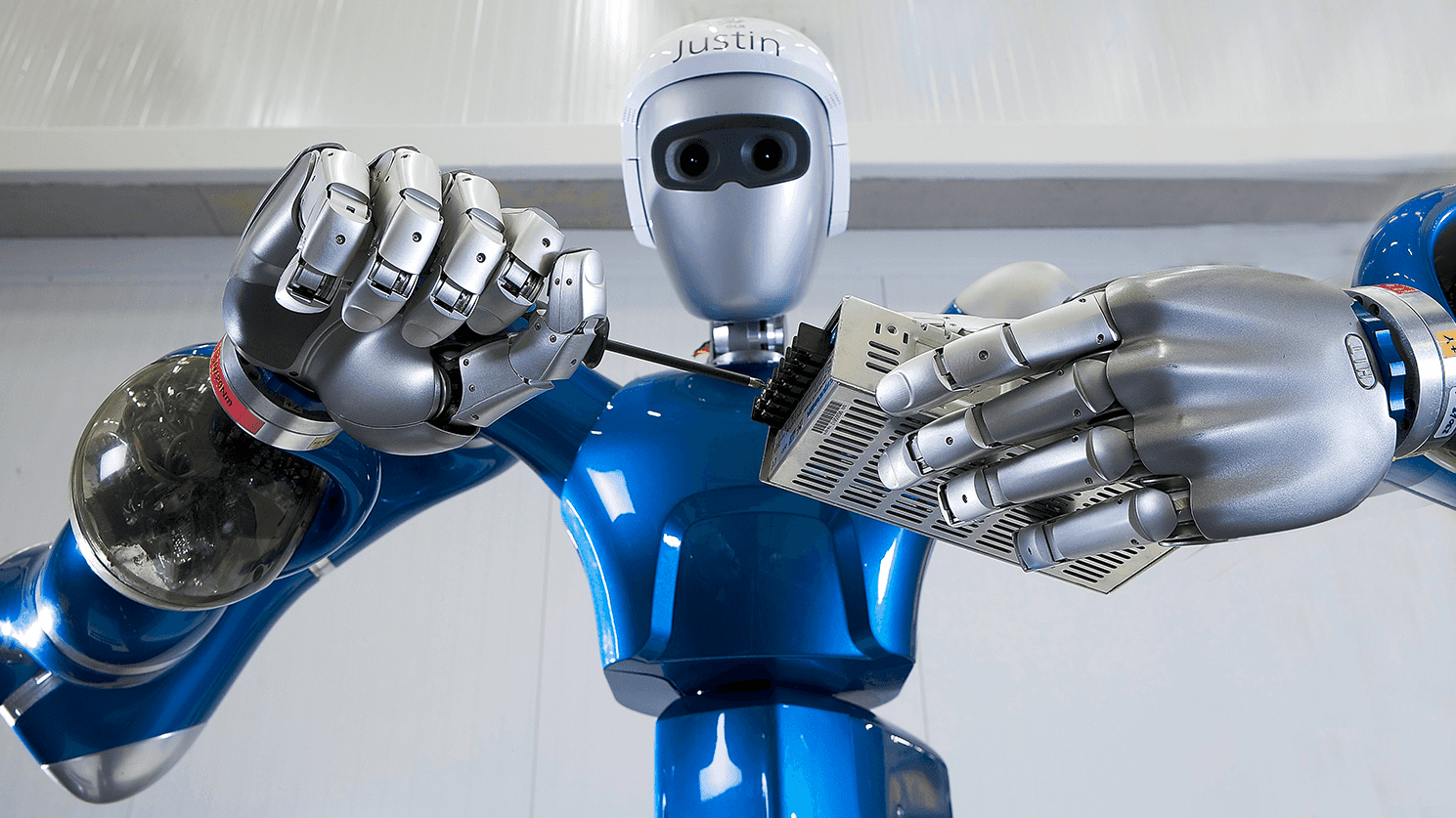description:
Robots. The mere word conjures up a bevy of mind-bending images pulled straight from popular science fiction tales. But robots aren’t just the stuff of entertainment. They’re real. They’re everywhere around you. And they’re transforming your life in ways you can’t imagine.
episodes:
01. The Arrival of Robot Autonomy
Plunge into the world of robots with this engaging introduction. When did we start thinking about robots? What three components are responsible for so many advances in robot design? Why is behavioral autonomy so essential to the development of modern robotics?
02. Robot Bodies and Trade-Offs
Why just watch robots when you can understand how they actually work? Deconstruct a Roomba to learn the five functional categories of parts all robots need. Then, explore a universal lesson about robotics: because robots can’t do everything well, trade-offs (such as simplicity versus maneuverability) are always involved.
03. Robot Actuators and Movement
Investigate robot actuators: the motors and transmissions that underlie all robotic movement. You’ll learn about the early use of springs as motors in automata; how electricity spins the magnets that make motors move; how movement defines what a robot is; and different types of motors (including DC and servo motors).
04. Robot Sensors and Simple Communication
Intelligent behavior in robots is rooted in the sensors that determine how much robots know about the world around them. Professor Long demonstrates how sensors work to communicate across the electromagnetic spectrum, including through infrared (like in Roombas) and visible light (for underwater robots that communicate using flashing blue lights).
05. Robot Controllers and Programming
What turns a remotely controlled machine into an autonomous robot? Self-control. So where does self-control in robots come from? Find out in this lecture on robot controllers: the computer-like part of robots that uses sensory information to decide how the robot should achieve its immediate and long-term goals.
06. Human-Inspired Robot Planning
In robotics, the most important problem mobile robots must solve is how to navigate, or move with purpose, in the world. Here, learn how simultaneous localization and mapping (using internal models, beacons, and dead reckoning navigation) is the key to a robot’s autonomy in both structured and exploratory situations.
07. Animal-Inspired Robot Behavior
Consider an approach to creating robots that’s inspired not by maps but by the simple sense-and-act behavior of animals. You’ll learn the benefits of behavior-based robotic architecture (including quicker reactions and stronger sensors), and see how simple animals including ants have inspired roboticists to build fascinating inventions.
08. Basic Skills for Making Robots
So you want to make a robot. Where should you start? Learn how to work with tools like multimeters and solid-core wires; how to perform basic tasks including stripping wire and building simple circuits; and how to “hack” into existing robots to get them to perform tasks they weren’t intended to do.
09. Designing a New Robot
Move from kits and hacks into the actual design and construction of more complex robots for research or business. As you explore the iterative decision-making process used by robotics engineers, you’ll meet intriguing robots including Madeline, the first transphibian vehicle, and RayBot, an artificial fish used for surveillance.
10. A Robot for Every Task?
Wouldn’t it be great to have a robot that took out your trash or put away your books? Explore how robots are designed to perform specific tasks, and the choices roboticists must consider in doing so-including the stability of the workplace and the minute steps of the task itself.
11. Robot Arms in the Factory
Each year, many tens of thousands of new robots are purchased to help us manufacture cars, medicines, and other everyday materials. And it all started with variations on the robotic arm. Here, examine early prototypes of pick-and-place robots; consider the trade-offs between range and control of motion; and ponder how far we’ve come with industrial robotics.
12. Mobile Robots at Home
Advancements in modern robotics have made robots useful, safe, reliable, easy to use, and affordable to have in our homes. So how exactly do different home robots-such as vacuum cleaners like Roomba, gutter cleaners like Looj, and lawn mowers like MowBot-adjust to the unique demands of their respective tasks?
13. Hospital Robots and Neuroprosthetics
Hospital robots have designs and functions meant to tackle the complexity of the modern medical workplace. First, discover how robots like HelpMate and Da Vinci work in patient wards, surgical theaters, and other settings. Then, delve into the burgeoning field of neuroprosthetics, which use the human nervous system for control of artificial limbs.
14. Self-Driving Vehicles
Lane changes, off-roading, irregular traffic patterns-how do robotic cars handle it all? Find out in this lecture on the trade-offs (especially between speed and safety) involved in creating self-driving vehicles. Peer into the future of how you’re likely to get from place to place, perhaps without having to do a thing.
15. Flying Robots: From Autopilots to Drones
Take to the air for an eye-opening look at aerial robots, from the autopilot features in commercial airplanes to unmanned drones that can deliver packages. Topics include the role of gyroscopic sensors and recent technological advancements that are extending the functionality and power of flying robots like never before.
16. Underwater Robots That Hover and Glide
Some of the most exciting robots on the planet are found underwater. Here, learn how today’s roboticists have developed unique solutions to creating autonomous underwater vehicles (AUVs), like Wave Glider, that have overcome critical challenges involving sensors, power supply, and design to do things like circumnavigate the globe or travel to great depths.
17. Space Robots in Orbit and on Other Worlds
Find out how space missions have pushed us to the limits of what autonomous robots can do. Central to this lecture are several fascinating robots, including Robonaut 2 (a humanoid robot working on the International Space Station) and the rovers Spirit and Opportunity, who are helping us better understand the complex geography of Mars.
18. Why Military Robots Are Different
Explore the tension between semi-autonomous military robots and our need to oversee their safety and control. In looking at military robots such as the Predator unmanned aerial system and the Phalanx weapons system, you’ll learn about the unique trade-offs involved in the speed and accuracy of action, and the ability to distinguish friend from foe.
19. Extreme Robots
Walking and running robots, whether they move on four legs or two, offer some of the most extreme physical challenges in all of robotics. What are the advantages of legged robots that make them so attractive to roboticists? How do robots with legs balance themselves and move around in different environments?
20. Swarm Robots
A huge challenge in robotics is getting robots to work as a team to do things they can’t do alone. Enter swarm robots: simple, similar mobile robots that combine to generate complex behaviors. Investigate this area of robotics that’s barely in its infancy, but has vast potential for scientific research, military defense, and more.
21. Living Robots?
Robots are starting to perform the core features of life, to the point where it may be possible to have a robot that actually “lives.” Professor Long introduces you to robots that “eat” by harvesting energy; robots that “grow” by building and improving themselves; and robots that “evolve” by designing themselves autonomously.
22. Social Robots
Enter the brave new world of social robotics, where robots are built specifically to communicate with humans and other autonomous physical agents. With the help of the robot Baxter, discover how simple signals like spoken words, expressions, and body language can create a dynamic user interface between human and robot.
23. Humanoid Robots: Just like Us?
Have we reached the point where robots are becoming just like-if not better than-human beings? Probe this fascinating question by examining recent developments in artificial intelligence, robot bipedalism and dexterity, the concept of the “uncanny valley,” and three imitation games (including the classic Turing test) to determine where we stand with humanoid robots.
24. The Futures of Robotics
Because it’s a multidisciplinary field, there isn’t just one future for robotics, but instead multiple futures. What could some of them look like? Consider everything from companion robots that can coordinate our activities to surgical robots that can work autonomously inside our bodies using updates from a “robotic cloud system.”










